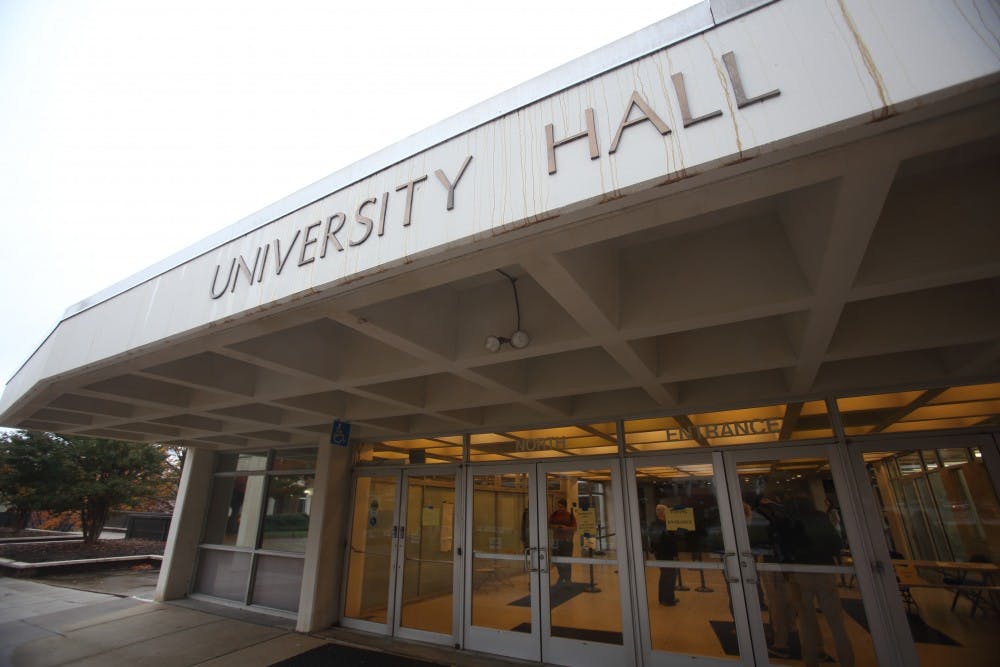With a headset and the two hand controls, anyone at the University will have the ability to virtually explore and interact with the now closed University Hall — which once was an athletic arena in active use for around 50 years — from the basketball court to the highest seats in the arena.
U-Hall has been out of use since 2015 and is slated for demolition during this summer mainly due to the popularity of the John Paul Jones Arena. This prompted a collaboration between University students, faculty and staff to develop a 3D virtual reality version of U-Hall in a virtual reality lab in Clemons Library. Having started in November 2018, this project is planned to become a library asset this year.
Will Rourk, a 3D content specialist in the Library’s Scholar Lab, Arin Bennett, a virtual reality specialist who manages the VR equipment and Shayne Brandon, a photogrammetry expert for the Institute for Advanced Technology in the Humanities, documented U-Hall with the use of 3D equipment and data-acquisition methods. They also use a process called photogrammetry, where a mass of 2D pictures is converted to 3D data. As soon as the data has been acquired, they will be able to rebuild U-Hall using virtual reality.
“The memory of this building will continue through our library archives,” Rourk said. “And we will be making all of this archival data available to the scholarly community without question.”
For this project, laser scanning, terrestrial laser scanning and terrestrial and aerial photogrammetry were some of the methods used to document U-Hall. Rourk was in charge of the laser scanning process. According to Rourk, the laser scanner that was used was a survey-grade laser scanner that sits on a tripod and shoots a laser out in space from its position. Each time the laser encounters a surface, it creates a point in space. Scanners called FARO focus 3D scanners are used for the terrestrial laser scanning, a ground-based active imaging method.
Brandon took photos using a digital single-lens reflex camera on the interior and mainly worked in the arena. He was in charge of photogrammetry, both terrestrial and aerial. Brandon flew a quadcopter, a multirotor helicopter propelled by four rotors, and got aerial photogrammetry of the whole site.
In comparison to terrestrial photogrammetry, aerial photogrammetry is helpful in capturing the roof of the building. The quadcopter acquires a mass of high-definition images that are put through photogrammetry software to provide 3D data of not only the roof but of the entire site of the building.
Brandon also uses a process where he combines laser data with photogrammetry data to produce precise 3D images textured using software. The laser scanner performs measurements, and the software takes this measured data, coupled with the high resolution photography, to create a 3D model.
Brandon has created a website for hosting the pictures and data for this project. He is currently working on populating the website with the data and documentation.
“The laser scanner is measuring everything down to the millimeter level,” Rourk said.
Dylan Gibbs, second-year Architecture student, became involved in this project through his architecture class, ARCH 2710, “Computer Aided Architectural Design/3D Geometrical Modeling and Visualization.” The class required students to recreate any building while simultaneously using the skills taught in this class, such as using computer-aided design and 3D geometrical modeling.
With the upcoming demolition of U-Hall, Gibbs seized this opportunity to recreate it with the hopes that the building can live on in a digital space.
“I thought the opportunity to recreate a structure that is soon to be demolished — and having a close proximity to the classroom — presented itself in such a way that would be hard to pass up,” Gibbs said in an in an email to The Cavalier Daily.
In this project, Gibbs catalogued the interior of U-Hall and was instantly amazed at the structure and architecture of the space — specifically the age of the building.
“I photographed major and minor elements and rendered them to attempt to keep the spirit of the building after it falls — with the hope that it can live on in a digital state,” he stated in the email.
To further this goal, Gibbs is interested in making the experience more interactive and engaging for students. One proposed idea is the creation of animated basketball players to simulate a real-life basketball game.
Alessandro Coreas, first-year College student, first learned about this project when he visited the virtual reality lab in Clemons Library.
“I think that the virtual reality version can provide a full experience of the building that can still live on among the student body and can still be celebrated for its rich history,” Coreas said. “The virtual reality version of University Hall may also encourage the U.V.a. student body to appreciate the building, from its intricate architecture to its nostalgic feel.”
Coreas hopes that this virtual reality experience will not just be limited to the U-Hall and that it will be available in all libraries on grounds.
For Rourk, the most rewarding experience in working on this project has been the process of the collecting the data that will eventually be archived by the library so the memory of U-Hall will continue through the library archives that are available to the whole community.
“Right now, it is not yet there,” Rourk said. “But we will make it a library asset that everyone can get their hands on.”







